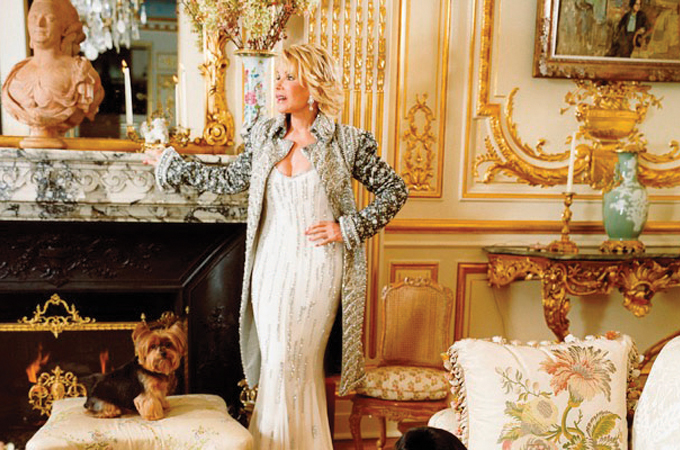I knew it, but I don’t believe most people realize Joan Rivers was a keen and accomplished collector of fine furniture, art and jewelry. How did I know? In 2004 I purchased the Rodarte tome New York Apartments: Private Views. As I turned to page 134, I landed in the study of Rivers’ Fifth Avenue penthouse, in all its gilded splendor! Her level of sophistication and taste astounded me. She purchased the penthouse in 1988, after being widowed. The limestone beauty, at 1 E. 62nd St., was built by John Drexel in 1903 and designed by famed architect Horace Trumbauer. After a complete remodel (and exorcism of an evil spirit), she generously used her home to raise money for countless charities. It isn’t any wonder that every Thanksgiving she hosted 50 people for a sit-down dinner and asked each to share what they were thankful for.
Recently Christie’s held a sale of her personal collections that netted in excess of $2 million. Rivers, generous even in death, specified the proceeds go to God’s Love We Deliver, an HIV charity, and Guide Dogs for the Blind.
She was often quoted saying, “My home is where Marie Antoinette would have lived if she had money.” That statement explains her design style, which was indeed reminiscent of Versailles. Rivers purchased only the best of the best, and shop owners around the world knew that Mrs. Rosenberg (as she was known in the real world) knew what she was looking at when shopping.
Her vast knowledge of Faberge, which she began collecting in 1968, developed into one of the finest collections in the world. The highest price at the auction, $245,000, was for a jeweled, gold-mounted nephrite photograph frame marked ‘Moscow 1898.’
The next-highest price, $161,000, was for a French ormolu-mounted mahogany sycamore and fruitwood marquetry commode, designed by François Linke with mounts by Léon Messagé, circa 1905. A dog lover all her life, she had a sterling Tiffany bowl engraved with her dog Spike’s name. That brought in $13,750.
In a world of instant gratification and mass production, it is a treat to know that someone this special loved, appreciated and curated all things wonderful. Thank you, Mrs. Rosenberg.
come to terms with … compagnonnage
The Compagnons du Tour de France is a French organization of craftsmen and artisans who have a Certificat d’Aptitude Professionelle diploma (the basic trade qualification) and who tour the country to apprentice with masters in their craft. In the process, the apprentices live in a Compagnon house managed by a mère. They are required to change locations every six months to a year in this process that combines professional training with community life and travel.
At the completion of their tour, which will take anywhere from five to eight years, they hopefully have honed their craft and mastered the skills required to excel in their chosen field. The concept of compagonnage dates to the Middle Ages!
buying tips
Never underestimate the importance of a rug. Frankly, it is where people make the most common and costly mistakes. There are some very simple rules, and keep in mind that often the correct choice costs more than what is in your budget.
In living rooms, a rug is meant to unite and define the space. If the room is extremely large, multiple rugs can accomplish this task, Layering smaller rugs on top of large sisal rugs also can create some interesting effects.
Fo
In dining rooms, chairs should never be off of the rug. Always allow at least 2 inches of exposed rug around your table to accommodate chairs when they are pulled out.
For bedroom rugs, make sure you don’t have more square feet under the bed than what is seen around the bed. Occasionally using individual runners around the bed can be the best answer.
A very important element is fiber and how it relates to wearability. Of course, always use a good dense pad, which increases the rug’s life and makes it more comfortable. Remember: “It is always better to want what you don’t have, than to have what you don’t want.”
